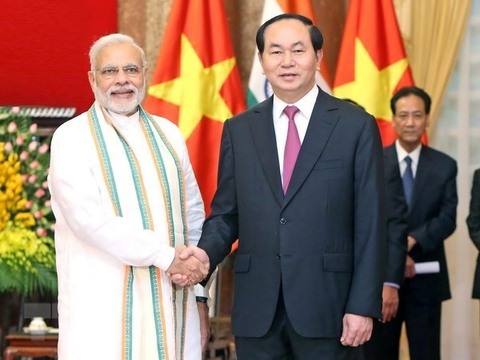
President Tran Dai Quang (r) receives Indian PM Narendra Modi in Viet Nam in September 2016. — VNA/VNS Photo Nhan Sang
President Tran Dai Quang’s upcoming official visit to India is expected to yield a road map for strengthening bilateral cooperation in the future. The visit, which will run from today to Sunday at the invitation of Indian President Ram Nath Kovind, is expected to also bring tangible benefits to the relationship in the present.
Potential not matched
After 46 years of diplomatic relations and 11 years of strategic partnership, the two countries have smoothly developed their co-operation in all fields.
According to the Viet Nam Ministry of Industry and Trade, India is the 15th largest commodity export market and the 10th largest import market of Viet Nam. This is reflected in the bilateral trade turnover that has remained stable at over US$5.5 billion and increased to $7.5 billion in 2017.
Vietnamese aricultural products have great export potential in the Indian market because they are high quality products with reasonable prices. In addition, electronics and computer accessories could find buyers in India.
Trade experts say that India is one of the leading suppliers of materials to Viet Nam’s textile and garment sector, especially after 2010, when the ASEAN Free Trade Agreement (ATIGA) came into effect.
Last year, India ranked the 17th out of 112 countries and territories investing in Viet Nam with total new capital investment, capital increase and share purchase in 11 months reaching $184.01 million.
Experts said India was the largest FDI partner of Viet Nam in the Central and West Asia region, with 164 projects and total registered capital of over $755 million. Most of the projects are concentrated in the fields of manufacturing, processing, information technology and mining.
Nguyen Xuan Trung, an expert from the Institute of Indian and Southwest Asian Studies, said that although the trade relations between Viet Nam and India had improved significantly compared to the previous period, they had not met the potential of the two countries.
“This is due to factors of culture, religion, working style, institutional differences and implementation of commitments. Moreover, the two sides’ businesses have very little information about each other’s market as well as corporate news,” said Trung.
Trung said most of the advantageous products of India are also the advantage products of Viet Nam, so the two economies are not complementary.
Tighten the relationship
In order to further develop the trade relations between Viet Nam and India, experts said that the two sides needed to strengthen mutual understanding, promote and introduce themselves on each side and improve efficiency and increase trade promotion activities.
Most important is the need for a bilateral trade agreement between Viet Nam and India, said experts.
According to the Vietnam Trade Office in India, many Indian businesses are eager to invest in Viet Nam, especially in the agricultural sector. Indian businesses hope to export a number of agricultural products such as grapes, sesame seeds and pomegranates. They also welcome Vietnamese firms to invest in building seafood processing plants and growing dragon fruit to meet the demand of over 1.3 billion people in the country.
Meanwhile, Viet Nam also wants India to create conditions for its businesses to continue exporting some key agricultural commodities such as coffee, rubber, cashew nuts and pepper, and consider importing products such as chicken, pig and fruit.
In a recent meeting with Minister of Industry and Trade Tran Tuan Anh, Indian Ambassador to Viet Nam Parvathaneni Harish said India was one of three comprehensive strategic partners of Viet Nam. India has paid much attention to the relationship with Viet Nam and considered the country as one of key pillars of its Act East Policy.
The ambassador said the co-operation between the two sides in the field of trade and economy still had much potential to exploit. The two sides hope to jointly exploit and promote co-operation in providing information on opportunities for investment in Viet Nam and India for businesses of the two countries.
Minister Anh affirmed that Viet Nam would continue to perfect its mechanisms, policies and business environment to attract investment and co-operation from abroad. India is one of the top priority partners in Viet Nam.
Anh hopes that the relationship between the two countries in general and co-operation in the field of economy, trade and industry in particular will be further developed, creating a favourable business environment and contributing to handling trade disputes between businesses of the two countries. They aim to increase bilateral turnover to $15 billion by 2020. — VNS